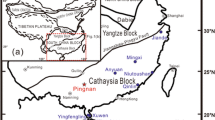Abstract
Mantle peridotites of the Internal Liguride (IL) units (Northern Apennines) constitute a rare example of the depleted lithosphere of the Jurassic Ligurian Tethys. Detailed chemical (ICP-MS and SIMS techniques) and isotopic investigations on very fresh samples have been performed with the major aim to constrain the timing and mechanism of their evolution and to furnish new data for the geodynamic interpretation. The data are also useful to discuss some general geochemical aspects of oceanic-type mantle. The studied samples consist of clinopyroxene-poor spinel lherzolites, showing incipient re-equilibration in the plagioclase-facies stability field. The spinel-facies assemblage records high (asthenospheric) equilibration temperatures (1150–1250° C). Whole rocks, and constituent clinopyroxenes, show a decoupling between severe depletion in highly incompatible elements [light rare earth elements (LREE), Sr, Zr, Na, Ti] and less pronounced depletion in moderate incompatible elements (Ca, Al, Sc, V). Bulk rocks also display a relatively strong M(middle)REE/H(heavy)REE fractionation. These compositional features indicate low-degree (<10%) fractional melting, which presumably started in the garnet stability field, as the most suitable depletion mechanism. In this respect, the IL ultramafics show strong similarity to abyssal peridotites. The Sr and Nd isotopic compositions, determined on carefully handpicked clinopyroxene separates, indicate an extremely depleted signature (87Sr/86Sr=0.702203–0.702285; 143Nd/144Nd=0.513619–0.513775). The Sm/Nd model ages suggest that the IL peridotites melted most likely during Permian times. They could record, therefore, the early upwelling and melting of mid ocean ridge basalt (MORB) type asthenosphere, in response to the onset of extensional mechanisms which led to the opening of the Western Tethys. They subsequently cooled and experienced a composite subsolidus evolution testified by multiple episodes of gabbroic intrusions and HT-LP retrograde metamorphic re-equilibration, prior to their emplacement on the sea floor. The trace element chemistry of IL peridotites also provides useful information about the composition of oceanic-type mantle. The most important feature concerns the occurrence of Sr and Zr negative anomalies (relative to “adjacent” REE) in both clinopyroxenes and bulk rocks. We suggest that such anomalies reflect changes in the relative magnitude of Sr, Zr and REE partition coefficients, depending on the specific melting conditions.
Similar content being viewed by others
Author information
Authors and Affiliations
Additional information
Received: 15 February 1995/Accepted: 4 August 1995
Rights and permissions
About this article
Cite this article
Rampone, E., Hofmann, A., Piccardo, G. et al. Trace element and isotope geochemistry of depleted peridotites from an N-MORB type ophiolite (Internal Liguride, N. Italy). Contrib Mineral Petrol 123, 61–76 (1996). https://doi.org/10.1007/s004100050143
Issue Date:
DOI: https://doi.org/10.1007/s004100050143




